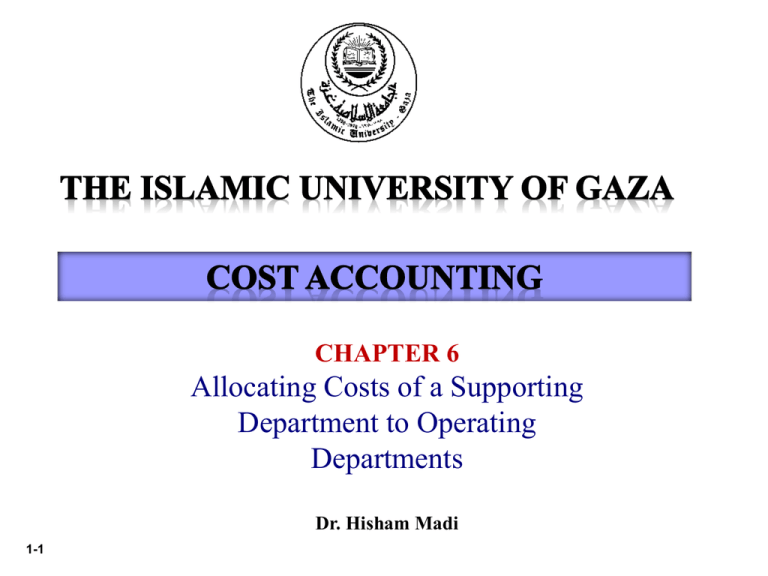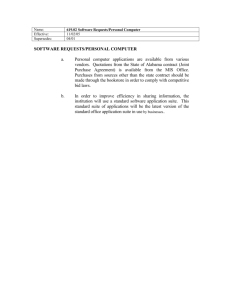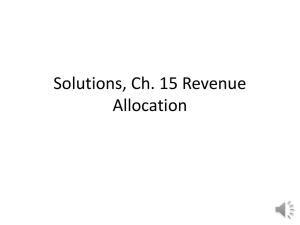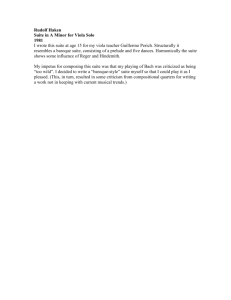Incremental Revenue
advertisement

CHAPTER 6 Allocating Costs of a Supporting Department to Operating Departments Dr. Hisham Madi 1-1 Overview of Methods Reciprocal is conceptually the most precise because it considers the mutual services provided among all support departments. Direct and step-down are simple to compute and understand. 1-2 Allocating Common Costs Common cost – a cost of operating a facility, activity, or like cost object that is shared by two or more users. Common costs arise because each user obtains a lower cost by sharing than the separate cost that would result if each user operated independently. The goal is to allocate common costs to each user in a reasonable way. 1-3 Methods of Allocating Common Costs: Stand-alone Stand-alone cost-allocation method—determines the weights for cost allocation by considering each user of the cost object as a separate entity to determine the cost-allocation weights. Example: Jason Stevens, a graduating senior in Seattle who has been invited to a job interview with an employer in Albany. The round-trip Seattle–Albany airfare costs $1,200. A week later, Stevens is also invited to an interview with an employer in Chicago. The Seattle– Chicago round-trip airfare costs $800. Stevens decides to combine the two recruiting trips into a Seattle–Albany–Chicago–Seattle trip that will cost $1,500 in airfare. The $1,500 is a common cost that benefits both prospective employers 1-4 Methods of Allocating Common Costs: Stand-alone For the common-cost airfare of $1,500, information about the separate (stand-alone) round-trip airfares ($1,200 and $800) is used to determine the allocation weights: 1-5 Methods of Allocating Common Costs: incremental cost-allocation method Incremental cost-allocation method ranks the individual users of a cost object in the order of users most responsible for a common cost and then uses this ranking to allocate the cost among the users. 1. 2. 3. 1-6 The first ranked user is the primary user and is allocated costs up to the costs as a stand-alone user (typically gets the highest allocation of the common costs). The second ranked user is the first incremental user and is allocated the additional cost that arises from two users rather than one. Subsequent users are handled in the same manner as the second ranked user Methods of Allocating Common Costs: incremental cost-allocation method • • • • 1-7 The difficulty with the method is that, particularly if a large common cost is involved, every user would prefer to be viewed as the incremental party. To sidestep disputes in such situations is to use the stand-alone cost allocation method. Another approach is to use the Shapley value, which considers each party as first the primary party and then the incremental party. The Shapley value method allocates, to each employer, the average of the costs allocated as the primary party and as the incremental party Bundled Products and Revenue Allocation methods Bundled product—a package of two or more products or services that is sold for single price, but whose individual components may be sold as separate items at their own “standalone” prices. Allocation issues can arise when revenues from multiple products are bundled together and sold at a single price. The methods for revenue allocation parallel those described for common-cost allocations. 1-8 Bundled Products and Revenue Allocation methods Revenues are inflows of assets companies receive for products or services provided to customers Revenue allocation occurs when revenues are related to a particular REVENUE OBJECT but cannot be traced to it in an economically feasible (cost-effective) way. Revenue object—anything for which a separate measurement of revenue is desired. The price of a bundled product is typically less than the sum of the prices of the individual products sold separately 1-9 Bundled Products and Revenue Allocation methods 1-10 A resort hotel may offer, for a single amount per customer, a weekend package that includes services from its lodging (the room), food (the restaurant), and recreational (golf and tennis) departments. When department managers have revenue or profit responsibilities for individual products, the bundled revenue must be allocated among the individual products in the bundle. Bundled Products and Revenue Allocation methods Examples: Dynamic Software Corporation, which develops, sells, and supports three software programs: 1. WordMaster, 2. DataMaster, 3. FinanceMaster, Dynamic Software sells these three products individually as well as together as bundled products. Dynamic Software allocates revenues from its bundled product sales (called “suite sales”) to individual products. Individual-product profitability is used to compensate software engineers, outside developers, and product managers responsible for developing and managing each product. How should Dynamic Software allocate suite revenues to individual products? 1-11 Bundled Products and Revenue Allocation methods Consider information pertaining to the three “stand-alone” and “suite” products in 2012: 1-12 Bundled Products and Revenue Allocation methods Stand-alone (separate) revenue allocation method uses productspecific information on the products in the bundle as weights for allocating the bundled revenues to the individual products. Three types of weights may be used: 1. Selling prices 2. Unit costs 3. Physical units. 1-13 Bundled Products and Revenue Allocation methods Stand-Alone Revenue-Allocation Method Consider the Word + Finance suite, which sells for $280. stand-alone method are as follows Selling prices. Using the individual selling prices of $125 for WordMaster and $225 for FinanceMaster, the weights for allocating the $280 suite revenues between the products are as follows: 1-14 Bundled Products and Revenue Allocation methods Stand-Alone Revenue-Allocation Method Unit costs. This method uses the costs of the individual products (in this case, manufacturing cost per unit) to determine the weights for the revenue allocations. 1-15 Bundled Products and Revenue Allocation methods Stand-Alone Revenue-Allocation Method Physical units. This method gives each product unit in the suite the same weight when allocating suite revenue to individual products. Therefore, with two products in the Word + Finance suite, each product is allocated 50% of t he suit e revenues. 1-16 Bundled Products and Revenue Allocation methods Which method is preferred? The selling prices method is best, because the weights explicitly consider the prices customers are willing to pay for the individual products The physical-units revenue-allocation method is used when any of the other methods cannot be used (such as when selling prices are unstable or unit costs are difficult to calculate for individual products). 1-17 Incremental Revenue-Allocation Method Incremental revenue-allocation method ranks individual products in a bundle according to criteria determined by management and then uses this ranking to allocate bundled revenues to individual products (similar to earlier discussed incremental cost-allocation method). 1. The first-ranked product is the primary product. 2. The second-ranked product is the first incremental product. 3. The third-ranked product is the second incremental product, and so on. 1-18 Incremental Revenue-Allocation Method How do companies decide on product rankings under the incremental revenue allocation method? Some organizations survey customers about the importance of each of the individual products to their purchase decision. Others use data on the recent stand-alone sales performance of the individual products in the bundle. A third approach is for top managers to use their knowledge or intuition to decide the rankings. 1-19 Incremental Revenue-Allocation Method Consider again the Word + Finance suite. Assume WordMaster is designated as the primary product. If the suite selling price exceeds the stand-alone price of the primary product, the primary product is allocated 100% of its stand-alone revenue If the suite price is less than or equal to the stand-alone price of the primary product, the primary product is allocated 100% of the suite revenue. All other products in the suite receive no allocation of revenue 1-20 Incremental Revenue-Allocation Method FinanceMaster is designated as the primary product and WordMaster as the first-incremental product. Then, the incremental revenue-allocation method allocates revenues of the Word + Finance suite as follows 1-21 Incremental Revenue-Allocation Method If Dynamic Software sells equal quantities of WordMaster and FinanceMaster, then the Shapley value method allocates to each product the average of the revenues allocated as the primary and first-incremental products: 1-22 Incremental Revenue-Allocation Method • But what if, in the most recent quarter, the firm sells 80,000 units of WordMaster and 20,000 units of FinanceMaster. • Because Dynamic Software sells four times as many units of WordMaster, its managers believe that the sales of the Word + Finance suite are four times more likely to be driven by WordMaster as the primary product. • The weighted Shapley value method takes this fact into account. It assigns four times as much weight to the revenue allocations when WordMaster is the primary product as when FinanceMaster is the primary product, resulting in the following allocations 1-23 Incremental Revenue-Allocation Method 1-24 Incremental Revenue-Allocation Method • When there are more than two products in the suite, the incremental revenue-allocation method allocates suite revenues sequentially. • Assume WordMaster is the primary product in Dynamic Software’s threeproduct suite (Word + Finance + Data). FinanceMaster is the firstincremental product, and DataMaster is the second-incremental product. • This suite sells for $380. The allocation of the $380 suite revenues proceeds as follows: 1-25 Incremental Revenue-Allocation Method Now suppose WordMaster is the primary product, DataMaster is the first-incremental product, and FinanceMaster is the secondincremental product. • The ranking of the individual products in the suite determines the revenues allocated to them. • Product managers at Dynamic Software likely would differ on how they believe their individual products contribute to sales of the suite products 1-26 1-27




